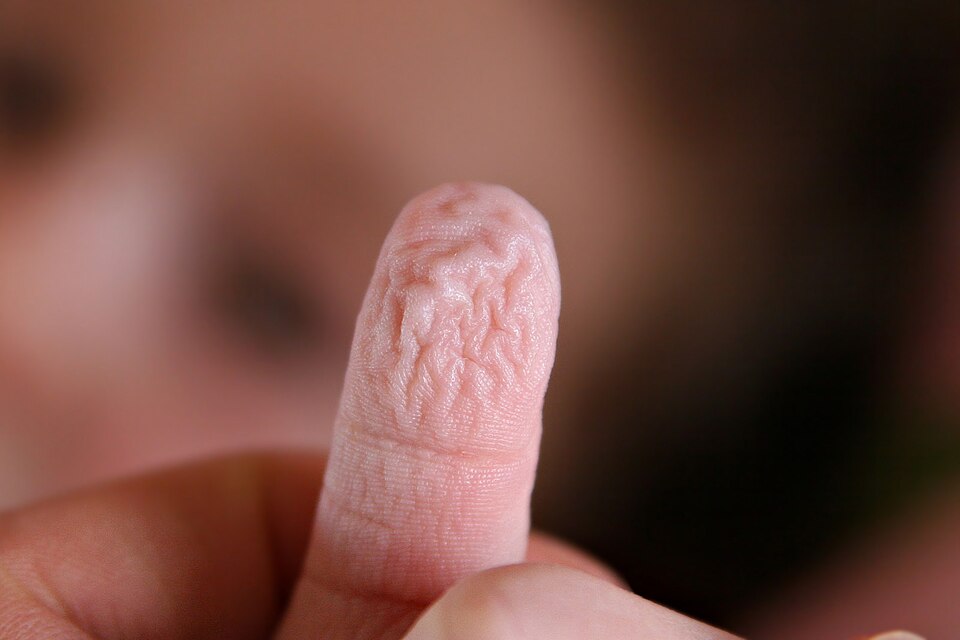
Why do fingers go wrinkly in the bath? Our fingers and toes go wrinkly when we are in the bath because of a nervous system response, not because the skin absorbs water from the bath.
If you are in a bath, your fingers and your toes will very quickly become extremely wrinkly. The length of time this takes depends on the temperature of the water. Water over 40 ℃ takes about 3.5 minutes to wrinkle the skin, and it can take over 10 minutes if the water is under 20 ℃. Each time your skin wrinkles, the pattern is exactly the same.
For a long time, it was thought that our fingers and toes wrinkled only because of osmosis. Osmosis happens when water moves from an area of higher water concentration to an area of lower water concentration. It was thought that the fingers and toes absorb water, and this makes them wrinkle. That turns out not to be the reason, though. If osmosis were the only reason why our fingers went wrinkly, then the skin would need to absorb a lot more water, which would make the whole hand swell. There would also be no reason why the wrinkles only appear on our fingers and toes. There should be wrinkles all over our skin.
Experiments on people with damage to their median nerve, which runs down the arm to the hand, showed that their fingers didn’t wrinkle. The only reason for this would be if our fingers wrinkling was an automatic nervous response. The autonomic nervous system is responsible for keeping our body ticking over and controls breathing, the heart, and many other things, including when our blood vessels dilate or contract. And this is what happens in the fingers. When our hands are immersed in water, the sweat ducts partially open and allow some water into the skin. This is the osmosis part. When the water gets into the skin, it lowers the salt concentration in the area, and sensors there send a signal to the brain to tell it that there is not enough salt. When we don’t have enough salt, the brain responds by constricting the blood vessels and which pulls on the skin, lowering areas on our fingers. The rest of the skin puckers up around these valleys, making the wrinkles. You can see that the blood vessels have been constricted because the hand becomes paler as blood flow is restricted. The pattern is always the same every time we get into a bath because the location of the blood vessels doesn’t change.
Scientists know what makes the fingers and toes wrinkle, but there is no consensus on why they wrinkle. Because it is a nervous response, the thought is that it must have evolved for a reason. However, that is not always the case. There are things that we have evolved that don’t make much sense. So long as they don’t have an impact on whether we can pass on our genes or not, there is no reason for us to lose them. Wrinkly fingers and toes could very well be one of these things. If we look past that and assume that they do have a reason, then what might it be? The most logical reason would be for increased grip. When participants in an experiment were asked to transfer dry and wet objects from one bowl to another using normal fingers, they took 17% longer when the objects were wet. When they repeated the experiment with wrinkly fingers, they were only 3% slower than when the objects were dry. This means the wrinkles almost completely cancel out the disadvantages of wetness.
The increased grip comes because of two reasons. Firstly, the wrinkles create troughs that channel the water away, allowing more skin to contact the object. This is the way that the grip on tires work. Secondly, when our fingers are wrinkled, it increases the friction between our fingers and the object. Our brains can sense that friction, and we can modify the amount of force we need to hold it. This helps us conserve our muscles, but it also means we can be more delicate, and there is less chance of the object slipping.
What use would this have been? It might have helped early humans find food in rivers. It could have helped them grip trees and rocks. It could have helped them to find seafood. Archaeological evidence shows that we started eating seafood about 164,000 years ago, and that increased our brain size. That would make sense. Humans whose skin wrinkled would have been able to find and eat more shellfish, giving them more food and a larger brain, which would have resulted in them being more able to pass on their genes. I wonder if we will ever know the reason. And this is what I learned today.
Sources
https://www.scientificamerican.com/article/why-do-our-fingers-and-toes-wrinkle-during-a-bath
https://www.news-medical.net/health/Why-Does-Skin-Go-Wrinkly-in-Water.aspx
https://www.scientificamerican.com/article/earliest-known-seafood-di
Image By fir0002flagstaffotos [at] gmail.comCanon 20D + Tamron 28-75mm f/2.8 – Own work, GFDL 1.2, https://commons.wikimedia.org/w/index.php?curid=343710
